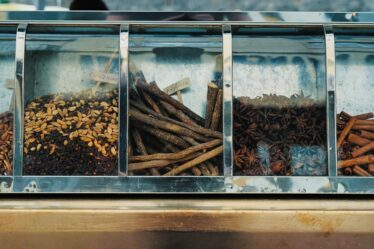
The Bonnet chili pepper, also known as the Scotch Bonnet, is a fiery and flavorful pepper that is popular in Caribbean and West African cuisine. It is believed to have originated in Central America and was brought to the Caribbean by Spanish explorers. The name “Bonnet” comes from its resemblance to a traditional Scottish hat, with its rounded shape and frilly top.
The Bonnet chili pepper is known for its vibrant colors, ranging from bright yellow to orange or red when fully ripe. It has a distinctive shape, with a round body and a wrinkled skin. The pepper is small to medium in size, typically measuring about 1-2 inches in diameter. Despite its small size, it packs a punch in terms of heat.
Key Takeaways
- Bonnet chili pepper is a popular pepper variety known for its heat and unique flavor.
- The flavor profile of Bonnet chili pepper is fruity, floral, and slightly sweet with a spicy kick.
- Using Bonnet chili pepper in your dishes can provide health benefits such as boosting metabolism and reducing inflammation.
- When choosing and storing Bonnet chili pepper, look for firm, shiny peppers and store them in a cool, dry place.
- Cooking with Bonnet chili pepper can be enhanced by using it in marinades, sauces, and rubs, and pairing it with ingredients like citrus, garlic, and honey.
The flavor profile of Bonnet chili pepper
The Bonnet chili pepper is not only known for its heat, but also for its complex flavor profile. It has a fruity and tropical taste, with hints of citrus and sweetness. The aroma of the Bonnet chili pepper is also distinct, with a strong and pungent scent that can be detected even from a distance.
In terms of heat level, the Bonnet chili pepper is considered to be very hot. It ranks high on the Scoville scale, which measures the spiciness of chili peppers. The heat of the Bonnet chili pepper is comparable to other hot peppers such as habanero and ghost peppers. However, it is important to note that the heat can vary depending on the individual pepper and how it is prepared.
Health benefits of using Bonnet chili pepper in your dishes
In addition to its fiery flavor, the Bonnet chili pepper also offers several health benefits. It is rich in vitamins A and C, which are important for immune function and overall health. The pepper also contains capsaicin, a compound that has been shown to have anti-inflammatory and pain-relieving properties.
Consuming Bonnet chili pepper can also help boost metabolism and aid in weight loss. The heat from the pepper can increase body temperature and stimulate the burning of calories. Additionally, capsaicin has been found to suppress appetite and reduce cravings for unhealthy foods.
How to choose and store Bonnet chili pepper
| Aspect | Recommendation |
|---|---|
| Appearance | Choose firm, shiny and smooth peppers with no wrinkles or blemishes. |
| Color | Look for bright red or green peppers, depending on the ripeness you prefer. |
| Smell | Smell the peppers to ensure they have a fresh and spicy aroma. |
| Storage | Store Bonnet chili peppers in a paper bag or airtight container in the refrigerator for up to two weeks. |
| Usage | Bonnet chili peppers are great for adding heat to dishes such as soups, stews, sauces and marinades. |
| Scoville Heat Units | Bonnet chili peppers have a range of 100,000 to 350,000 Scoville Heat Units, making them very spicy. |
When selecting fresh Bonnet chili peppers, look for peppers that are firm and free from blemishes or soft spots. The color should be vibrant and consistent throughout the pepper. Avoid peppers that are overly wrinkled or have a dull appearance, as this may indicate that they are past their prime.
To store Bonnet chili peppers, place them in a paper bag or perforated plastic bag and store them in the refrigerator. This will help to extend their shelf life and maintain their freshness. Avoid storing them in airtight containers, as this can cause moisture buildup and lead to spoilage.
Cooking with Bonnet chili pepper: Tips and tricks
Before using Bonnet chili peppers in your cooking, it is important to handle them with care. The oils from the peppers can cause skin irritation, so it is recommended to wear gloves when handling them. If you do come into contact with the peppers, wash your hands thoroughly with soap and water.
To prepare Bonnet chili peppers for cooking, start by removing the stem and seeds. The seeds are where most of the heat is concentrated, so removing them can help to reduce the spiciness of the pepper. You can then chop or slice the pepper according to your recipe’s requirements.
When cooking with Bonnet chili peppers, it is important to keep in mind that a little goes a long way. Start with a small amount and gradually increase the heat level to suit your taste. Remember that the heat of the pepper can intensify during cooking, so it is better to add more later if needed.
Recipes to try with Bonnet chili pepper

1. Spicy Bonnet chili pepper salsa recipe:
– Ingredients:
– 4 Bonnet chili peppers, seeded and finely chopped
– 2 tomatoes, diced
– 1 small red onion, finely chopped
– 1 clove of garlic, minced
– Juice of 1 lime
– Salt and pepper to taste
– Instructions:
1. In a bowl, combine the chopped Bonnet chili peppers, tomatoes, red onion, and garlic.
2. Squeeze the lime juice over the mixture and season with salt and pepper.
3. Stir well to combine all the ingredients.
4. Let the salsa sit for at least 30 minutes to allow the flavors to meld together.
5. Serve with tortilla chips or as a topping for grilled meats or fish.
2. Bonnet chili pepper chicken recipe:
– Ingredients:
– 4 boneless, skinless chicken breasts
– 2 Bonnet chili peppers, seeded and finely chopped
– 2 cloves of garlic, minced
– Juice of 1 lemon
– Salt and pepper to taste
– Instructions:
1. Preheat the grill to medium-high heat.
2. In a small bowl, combine the chopped Bonnet chili peppers, minced garlic, lemon juice, salt, and pepper.
3. Place the chicken breasts on a plate and pour the marinade over them.
4. Use your hands to massage the marinade into the chicken, ensuring that it is evenly coated.
5. Let the chicken marinate for at least 30 minutes.
6. Grill the chicken for about 6-8 minutes per side, or until cooked through.
7. Serve hot with your favorite side dishes.
3. Bonnet chili pepper shrimp recipe:
– Ingredients:
– 1 pound of shrimp, peeled and deveined
– 2 Bonnet chili peppers, seeded and finely chopped
– 2 cloves of garlic, minced
– Juice of 1 lime
– Salt and pepper to taste
– Fresh cilantro, chopped (for garnish)
– Instructions:
1. In a large bowl, combine the chopped Bonnet chili peppers, minced garlic, lime juice, salt, and pepper.
2. Add the shrimp to the bowl and toss to coat them in the marinade.
3. Let the shrimp marinate for about 15 minutes.
4. Heat a large skillet over medium-high heat and add the shrimp along with the marinade.
5. Cook the shrimp for about 2-3 minutes per side, or until they are pink and cooked through.
6. Remove from heat and garnish with fresh cilantro.
7. Serve hot with rice or as a filling for tacos or wraps.
Pairing Bonnet chili pepper with other ingredients
The intense heat of the Bonnet chili pepper can be balanced out by pairing it with complementary flavors and ingredients. Some ingredients that pair well with Bonnet chili pepper include:
– Tropical fruits such as mango, pineapple, and papaya: The sweetness of these fruits helps to offset the spiciness of the pepper.
– Creamy ingredients such as coconut milk or yogurt: The creaminess helps to mellow out the heat and adds a rich texture to dishes.
– Acidic ingredients such as lime or vinegar: The acidity helps to cut through the spiciness and adds a tangy flavor to dishes.
– Fresh herbs such as cilantro or mint: The freshness of these herbs can help to balance out the heat and add a burst of flavor to dishes.
When using Bonnet chili pepper in your recipes, it is important to taste as you go and adjust the flavors accordingly. Adding a small amount of sugar or honey can also help to balance out the heat if needed.
Bonnet chili pepper in international cuisine
The Bonnet chili pepper is a staple ingredient in many international cuisines. Here are some examples of how it is used in different dishes:
– Caribbean cuisine: The Bonnet chili pepper is a key ingredient in jerk seasoning, which is used to marinate and flavor meats such as chicken and pork. It is also used in traditional Caribbean dishes such as curry goat and pepperpot stew.
– West African cuisine: The Bonnet chili pepper is used in many West African dishes, including jollof rice, a popular one-pot rice dish. It is also used in soups, stews, and sauces to add heat and flavor.
– Mexican cuisine: While the Bonnet chili pepper is not native to Mexico, it is often used as a substitute for habanero peppers in Mexican cuisine. It is used in salsas, hot sauces, and marinades for meats and seafood.
– Indian cuisine: The Bonnet chili pepper is used in many Indian curries and chutneys to add heat and flavor. It is also used in pickles and relishes.
Growing your own Bonnet chili pepper plant at home
If you enjoy cooking with Bonnet chili peppers, you may want to consider growing your own plant at home. Here are some tips on how to grow and care for Bonnet chili pepper plants:
– Choose a sunny location: Bonnet chili peppers thrive in full sun, so choose a spot in your garden that receives at least 6-8 hours of direct sunlight per day.
– Prepare the soil: The soil should be well-draining and rich in organic matter. You can amend the soil with compost or well-rotted manure to improve its fertility.
– Start from seeds or seedlings: You can start Bonnet chili pepper plants from seeds or purchase seedlings from a nursery. If starting from seeds, sow them indoors about 8-10 weeks before the last frost date.
– Transplant outdoors: Once the danger of frost has passed and the soil has warmed up, transplant the seedlings outdoors. Space them about 18-24 inches apart to allow for proper air circulation.
– Water regularly: Bonnet chili pepper plants require regular watering, especially during hot and dry periods. Keep the soil evenly moist, but avoid overwatering, as this can lead to root rot.
– Fertilize regularly: Use a balanced fertilizer every 4-6 weeks to provide the plants with essential nutrients. Follow the instructions on the fertilizer package for application rates.
– Harvesting: Bonnet chili peppers can be harvested when they are fully ripe and have reached their desired color. Use scissors or pruning shears to cut the peppers from the plant, leaving a short stem attached.
Growing your own Bonnet chili pepper plant can be a rewarding experience and provide you with a fresh supply of peppers for your cooking.
Elevate your cooking game with Bonnet chili pepper
In conclusion, the Bonnet chili pepper is a versatile and flavorful ingredient that can add a new level of heat and complexity to your dishes. Its fruity taste and intense heat make it a favorite among spice lovers around the world. Not only does it bring flavor to your meals, but it also offers several health benefits.
Whether you choose to use it in salsas, marinades, or curries, the Bonnet chili pepper is sure to elevate your cooking game. So why not give it a try and experiment with this fiery pepper in your next culinary adventure? Your taste buds will thank you!
If you’re a fan of the fiery bonnet chili pepper, you’ll love this article on Flavorful Sips that explores the power of green juice and how it can help you achieve wellness. Green juice is packed with nutrients and antioxidants, making it a great addition to your daily routine. Whether you’re looking to boost your immune system or detoxify your body, this article provides valuable insights and delicious recipes to help you get started. Check it out here and unleash the power of green juice for a healthier lifestyle.



